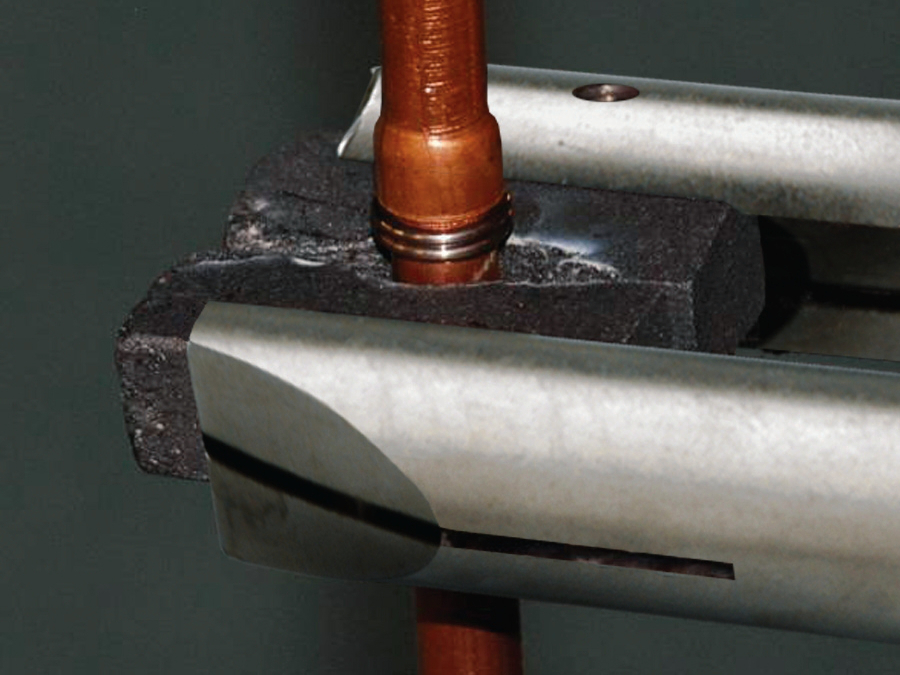You may have heard of resistance welding, but have you heard of resistance brazing? In this article, we explain what this technique is, how it is performed, and what the advantages are in using it.
What is Resistance Brazing?
Resistance brazing is the process of joining two metals using a low-temperature interface metal called the “brazing alloy.” The goal is to join the two metals by melting the alloy without simultaneously melting the metals. The heat is supplied by the same resistance to current flow as spot welding but the workpiece is not melted. Instead, a small piece of braze alloy is inserted at the joint which melts at a lower temperature to form the bond between the parts to be jointed. Because the technique is focused on melting the alloy, the two metals being joined can have very different melting temperatures, crystalline structures, and thermal loads. Resistance brazing differs from other forms of resistance welding, such as butt welding, spot welding, flash welding, and seam welding. The presence of a joining alloy is what makes this technique unique.
The Process of Resistance Brazing
The process is relatively simple: the two primary metal pieces are placed together with the braze alloy between the two at the joining point. A force is applied to the metal pieces, holding them together for the current to flow without arcing. The current then passes through the metals, melting the braze alloy to join the pieces. After melting, the current is turned off and the braze alloy solidifies under light pressure. Once a solid joint forms, the two parts are considered brazed together.
Use The Right Force
The force applied to the metals must be strong enough to avoid arcing while also light enough to ensure that the molten brazing alloy will not be squeezed out of the joint. This would weaken the joint. With resistance brazing, the optimum thickness of the joint is a thickness of .0015” to .003”. The force applied to the joint must be sufficient to hold the parts together and allow the alloy to melt and solidify. In such a delicate situation, it may be necessary to dial down the force to well under one hundred pounds. Many machines are not adjustable to such low levels of force. As a result, some resistance brazers use spring force that can be adjusted to as low as ten pounds to ensure proper placement of the brazing alloy through the entire process.
Electrode Types for Brazing
Because resistance brazing passes the current through the metals that are being joined, the electrodes that are used in the process do not have to be designed to concentrate heat in a particularly small area. Instead, the electrodes are designed to contact a larger area or maybe the entire surface of the workpiece. In many cases—particularly in resistance brazing on small pieces—a vacuum is run through the center of the electrode to assist in loading the components and holding them in place during the brazing process. The electrode material is usually RWMA Class 2 and could be copper or carbon. Water cooling for the electrodes or holders is always a good idea to encourage electrode life.
Advantages of Resistance Brazing
There are several advantages to resistance brazing over other techniques that might be considered for the joining of the two metals.
- Brazing allows for the joining of materials by which other resistance welding techniques may not be as successful. Copper and brass, for example, are conductive materials that are hard to get hot enough with resistance heat to form a weld nugget. Here, resistance brazing is successful at much lower currents to melt the braze alloy and join the pieces. The technique is perfect for joining small electronic metal components—especially those that are silver- or copper-backed-- that are both electrical and thermally conductive but can’t withstand the heat soaking for the extended periods of other techniques. The technique is also excellent on small decorative pieces. Resistance brazing allows joining at much lower temperatures.
- Resistance brazing is conducted at much lower temperatures than many other techniques. The piece does not have to be brought to a melting point—only the braze alloy needs to reach a melting point, which is always much lower than the pieces being joined. Because of the lower heat levels involved, post-application heat treatment may not be necessary, and the workpiece can preserve nearly all of its mechanical properties.
- The heat application can be focused on a small area of the parts being joined. That, coupled with the low temperatures means that the brazing affected area is contained in a smaller area.
- In the past, the limitations of assembly geometry restricted techniques to simple, small, flat-plane uses. But technological advances in assembly styles have introduced complexity and versatility to the resistance brazing process.
- Resistance brazing techniques are ideal for jobs that require repeat processes with a quick cycle time and low thermal distortion. No external features are necessary, and in most cases, the pressure from the electrodes is enough to hold the assembly in place.
Resistance Brazing Safety
Many of the above advantages suggest that resistance brazing is safe for the operator. And, while the cycle time is quick and the temperatures are relatively low, there are still safety concerns associated with this technique:
- As the braze alloy is molten, it is necessary to always consider and be aware of the possibility of spatter or seeping from the weld point. Constant attention should be paid to the pressure placed on the pieces as well as the temperature of the contact areas of the electrodes.
- Some exhaust may be necessary to remove any fumes generated by the melted braze alloy or fluxes.
- Stay aware of the electrodes to avoid contact.
As with any job where inherent dangers exist, it is necessary to be mindful of safety considerations. Always follow the safety protocols, including safety gear, regardless of how low-key or repetitive resistance brazing may seem. Gloves, goggles, and earplugs are all required for proper operation of the equipment, and any additional warnings or guidelines made by the equipment manufacturer, or the employer should be followed consistently.
Summary
Resistance brazing is a variation of resistance welding. It is useful in situations where other resistance welding techniques are ineffective or impossible to perform. We have summarized what this technique is and how it is performed, as well as some advantages. We also reminded you of some safety considerations to be aware of.
We release helpful content for the resistance welding industry every week. Stay up to date by following us on LinkedIn, Facebook, and Twitter, as well as coming back to visit our website. Happy welding!



